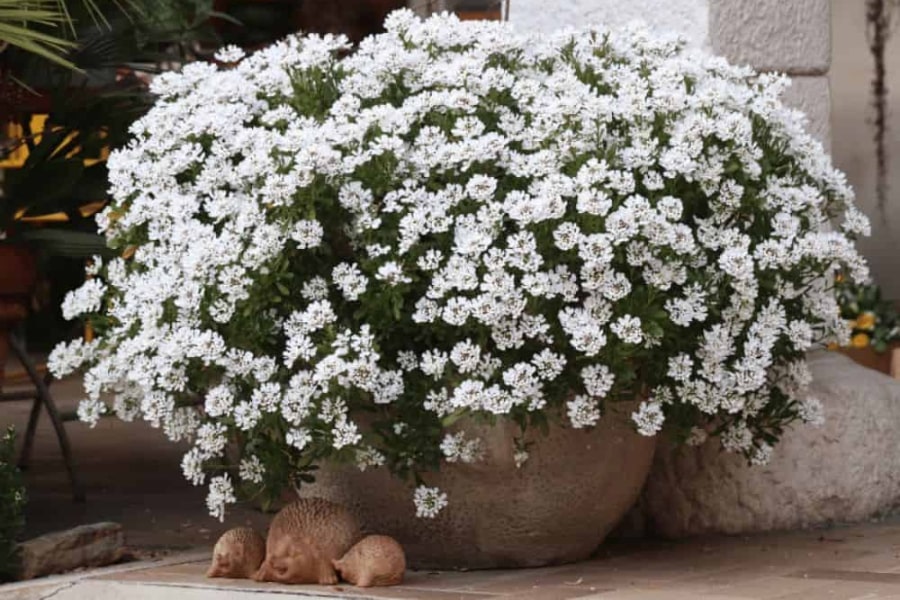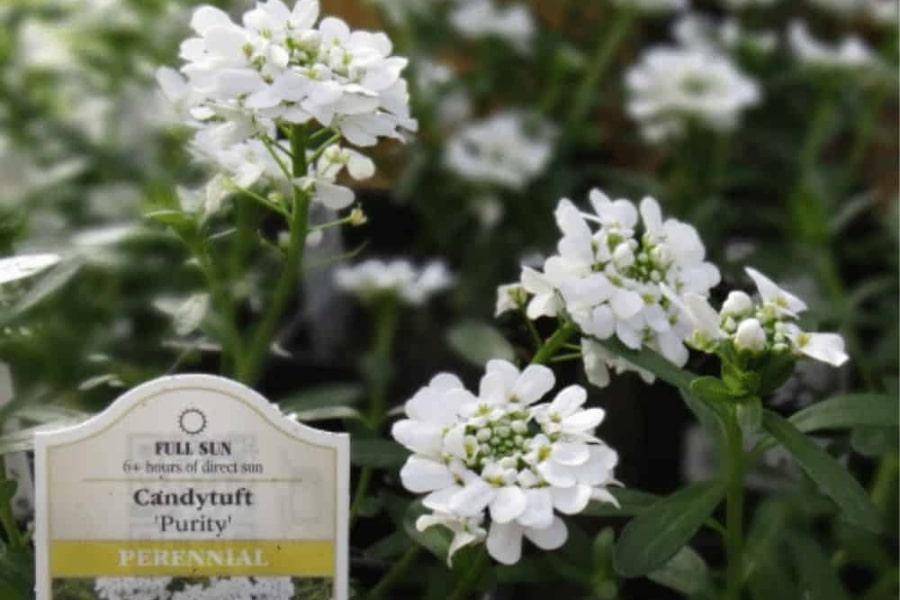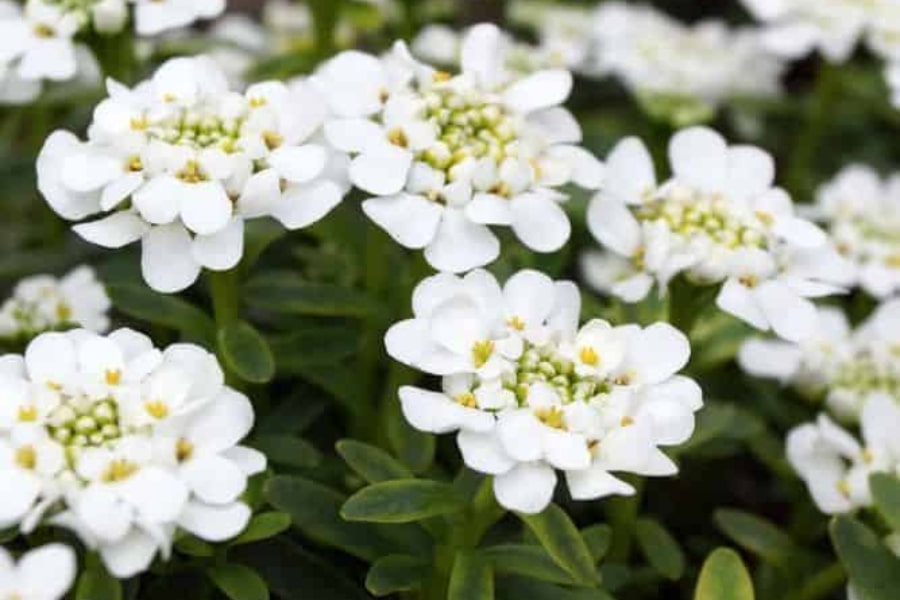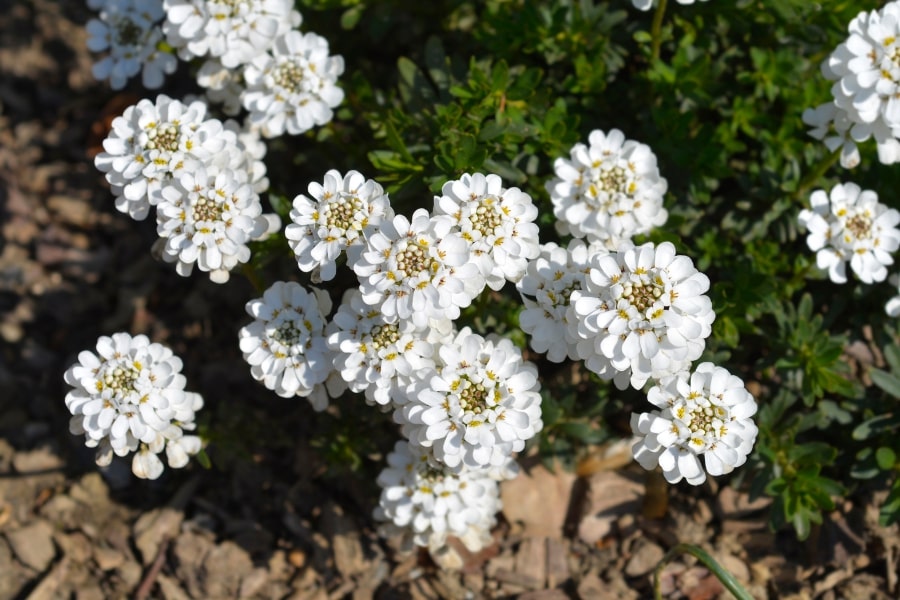Iberis, commonly known as Candytuft, is a genus of flowering plants in the family Brassicaceae. It includes approximately 50 species of annuals and perennials, most of which are native to Europe, North Africa, or Western Asia. Iberis is known for its dainty flowers, verdant foliage, and exceptional versatility in garden design. One of the most attractive features of Candytuft is its sweet fragrance, which is particularly strong in some species. The scent is most noticeable on warm, sunny days and can attract pollinators, including bees and butterflies.

Our Selection Of Candytuft
At Martin Garden Center, we usually begin seeing 4″ Candytuft in February. It is one of the earliest bloomers in the Spring and enjoys the cool climate. After its Spring blooming display, Iberis foliage may remain but, in some instance, may die back in harsher direct sun environments. We both brow and receive Candytuft from our vendors, such as Alexander’s White, Snowsation, and Summer Snowdrift.
We are growing the following varieties in 2025:

Growing and Caring For Candytuft
Candytuft is adaptable to various temperatures. It can withstand heat and cold, although it may benefit from protection during extreme weather conditions, such as severe frosts. The plant flourishes in full sun to light shade. While it can tolerate partial shade, its blooms shine in sunnier locations. Placing Iberis in a spot that receives at least six hours of direct sunlight daily results in robust growth and abundant flowering.
Well-draining soil is paramount to the plant’s success. It prefers soil with good drainage, as waterlogged conditions can lead to root rot and other issues. Amending the soil with compost or organic matter enhances its texture and drainage capabilities, creating an ideal medium for healthy growth. Although it is relatively drought-tolerant once established, consistent moisture is crucial during its initial growth phase. Once established, water it moderately, allowing the soil to dry slightly between waterings.
Candytuft are relatively disease and pest-resistant, but it’s still a good practice to monitor for any signs of pests and address them if necessary. Note that because Candytuft is a cool season plant, it may die back in the hot summer only to rebound in the later fall or early spring.
Leaves and Flowers
Iberis has small, lance-shaped leaves that are evergreen in many varieties. These leaves form a lush and vibrant backdrop, serving as a canvas against which the plant’s exquisite flowers stand out.
Its delicate flowers bloom in clusters and range from pure white to shades of pink and lavender, depending on the cultivar. The flowers bear four or five petals each, creating a star-like appearance that exudes elegance and grace.

Uses in the Garden
- Borders and Edging: Candytuft’s low-growing habit and captivating blooms make it an excellent choice for bordering garden beds and pathways. Its tidy growth adds definition and structure to landscapes while infusing a touch of elegance.
- Rock Gardens: Candytuft thrives in rock gardens, whose compact form and vibrant flowers contrast strikingly against rugged stone textures. Its ability to thrive in well-draining soil is particularly advantageous in rock garden settings.
- Container Gardening: The adaptability of Candytuft extends to container gardening. Planted in pots and containers, it creates charming focal points on patios, balconies, and decks. Mixed with other plants, it contributes to captivating and dynamic displays.
- Pollinator Gardens: Candytuft’s flowers act as magnets for pollinators, making them valuable assets in pollinator-friendly gardens. Candytuft supports local ecosystems and fosters biodiversity by attracting bees, butterflies, and other beneficial insects.
- Ground Cover: In areas where ground cover is desired, Candytuft can be a splendid choice. Its spreading growth habit and evergreen foliage form a lush carpet that adds visual interest and texture to open spaces.

Frequently Asked Questions
Is Candytuft a Perennial?
Yes, Candytuft (Iberis) is a perennial plant. There are several species and cultivars within the Iberis genus, many of which are perennials. Perennials are plants that live for more than two years, returning each growing season.
Is Candytuft Deer Resistant?
Candytuft is considered to be deer-resistant due to its fragrant foliage, unpalatable taste, and texture, which deer find less appealing. While Candytuft is not completely immune to deer feeding, it is less likely to be a target for them compared to more preferred food sources.
How Long Does Candytuft Bloom?
Candytuft is known for its relatively long blooming period. The exact duration of the bloom can vary depending on the specific species or cultivar, local climate, and growing conditions. Generally, Candytuft tends to bloom in spring, and the flowering period can last several weeks. While the peak of the bloom is typically in spring, some cultivars may continue to produce sporadic blooms through early summer.
Why Is My Candytuft Dying?
Several factors can contribute to the decline or death of Candytuft (Iberis). Some common reasons why your Candytuft might be struggling include:
- Poor Soil Drainage: Candytuft prefers well-draining soil. If the soil retains too much water, especially during the winter, the plant’s roots can become waterlogged, leading to root rot.
- Overwatering or Underwatering: Both overwatering and underwatering can stress Candytuft. Find a balance by watering the plant when the soil is slightly dry to the touch. Waterlogged or drought-stressed plants may exhibit wilting, yellowing, or dieback.
- Disease: Fungal diseases like powdery mildew or root rot can affect Candytuft. These issues may arise from poor air circulation, overwatering, or planting in soil that retains too much moisture.
- Pests: Aphids, spider mites, or other pests can infest Candytuft, causing damage to the foliage and overall health of the plant. Inspect your plants regularly for signs of pest infestation.
- Environmental Stress: Harsh weather conditions, such as extreme temperatures or prolonged exposure to strong sunlight, can stress Candytuft. Ensure it is planted in a location with the appropriate light conditions for its specific variety.
- Nutrient Deficiency: Lack of essential nutrients, especially in poor or depleted soils, can contribute to the decline of Candytuft. Consider fertilizing with a balanced, slow-release fertilizer according to the plant’s needs.
